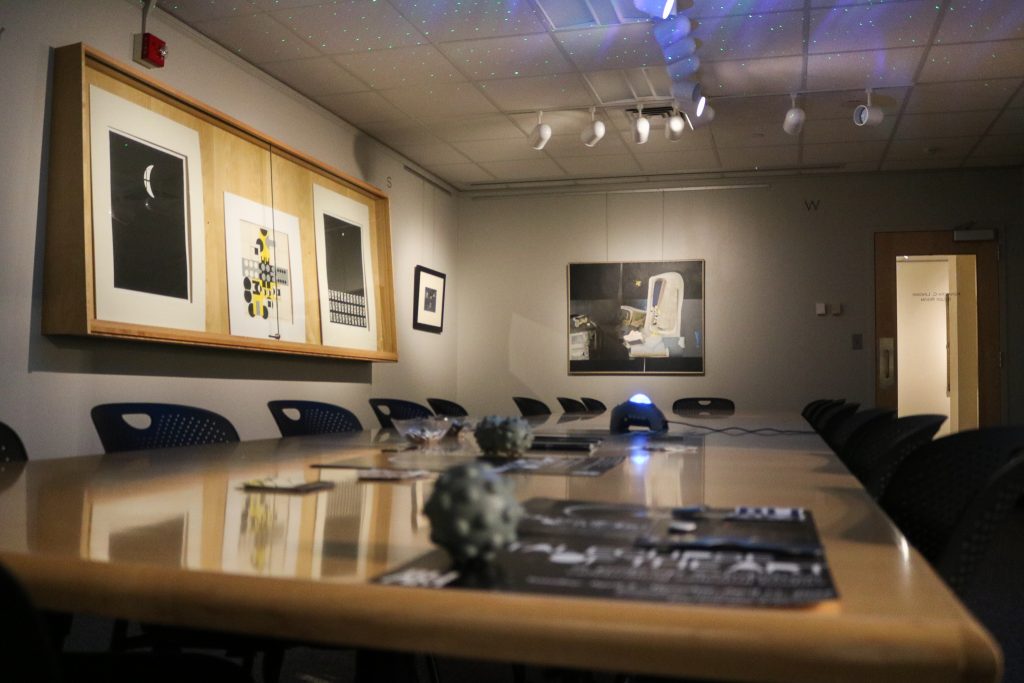As the April 8 solar eclipse draws near, the Binghamton University Art Museum (BUAM) has unveiled an exhibition fit to honor the event. The pop-up exhibition, cleverly entitled “Total Eclipse of the Art: A pop-up exhibit celebrating celestial bodies,” that features works that involve the sun, moon and stars across time and space.
The total solar eclipse, which cross North America on Monday, April 8, is the first solar eclipse visible in the United States since 2017. Roughly 31.6 million people live in the path of totality, or the area where the moon will fully eclipse the sun. In Binghamton, the eclipse will begin at 2:08 p.m., and will last until 4:34 p.m. However, Binghamton will not reach totality during the duration of the eclipse.
Jessica Petrylak, the co-curator of “Total Eclipse of the Art” and the art preparator and communications assistant at BUAM, wanted to engage the student body on a level they would relate to.
“It is beneficial for the museum to engage with our community on topics and events that are relevant to their day-to-day,” Petrylak wrote in an email. “This eclipse is a once-in-a-lifetime opportunity that engages everyone. I think through this exhibition, we see a common fascination with celestial bodies. We can always count on artists to preserve these memories and fascinations through the visual arts.”
The exhibition features a number of different styles and mediums of artwork. One of the first pieces visitors see when entering the room, “Sun” by Lora Mogenstern, challenges expectations with a mosaic-encrusted dish. The bright yellow and gold contrasted with black and brown catches a viewer’s eye as much as the shine of the piece. Other works include “HINC ALIQUANDO ELUCTABAR” from “Dialogo dell’imprese Militari et,” a woodcut by an unknown artist dating back to 1559, and “Flowering Plum and Moon,” a 1920s polychrome wood block print by Ohara Koson, featuring stark white petals against a black background.
The display of multimedia works in the exhibition was no accident. Amanda Lynn, the other co-curator of “Total Eclipse of the Art” and the coordinator of education and public programs at BUAM, discussed that she and Petrylak were striving to inspire students as well as showcase their collection through the multimedia display.
“We worked to try and incorporate multiple mediums to highlight our multifaceted collection and hope to inspire students and staff to come explore what we have to offer here at BUAM,” Lynn wrote in an email.
When asked why she thought this exhibition was important, Lynn mentioned that the hope is to expand the idea of what a viewing experience of the eclipse could entail.
“This is a once-in-a-lifetime opportunity, and we hope that by being a part of the festivities, we can help visitors make connections to the eclipse and enhance their viewing experience,” Lynn wrote.
The exhibition was designed to engage the student body in a way that would relate to their viewing experience, much like the BUAM itself. Eliana Ellerton, a gallery guard and art education assistant at the BU Art Museum and a first-year graduate student studying history, said she wants students to know that this event could really appeal to the student body.
“We’re a university art museum, so everything that we do is centered [around] not just the general public and the promotion of art, but also for the overall benefit of the students who go here,” Ellerton said. “The eclipse that is coming up is a once in a lifetime event … so not only do we want to promote these great artists, [but we also want to] engage the student body intellectually.”
“Total Eclipse of the Art: A pop-up exhibit celebrating celestial bodies” will be shown through Thursday, April 11 in the Kenneth C. Lindsay Study Room in the Lower Galleries, and is free and open to the public.



